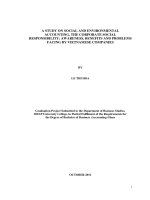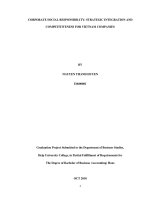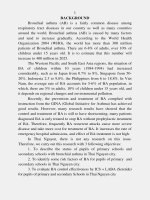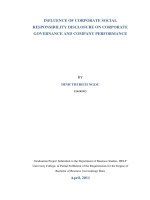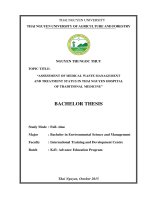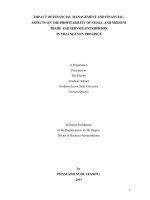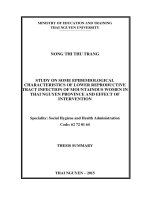Corporate social responsibility employee commitment and organizational performance in banking industry in thai nguyen province
Bạn đang xem bản rút gọn của tài liệu. Xem và tải ngay bản đầy đủ của tài liệu tại đây (1.1 MB, 124 trang )
CORPORATE SOCIAL RESPONSIBILITY, EMPLOYEE
..
COMMITMENT AND ORGANIZATIONAL PERFORMANCE IN
BANKING INDUSTRY IN THAI NGUYEN PROVINCE
A DISSERTATION PAPER
Presented to
School of Graduate Studies
Central Philippine University, Philippines
In Collaboration with
Thai Nguyen University, Vietnam
In Partial Fulfillment
Of the Requirements for the Degree
DOCTOR OF MANAGEMENT
NGUYEN HONG HAI
JUNE 2020
NGUYEN HONG HAI
MARCH 2020
i
ACKNOWLEDGEMENT
The author wishes to convey the gratitude to the following persons who
wholeheartedly devoted and helped make this piece of work a reality:
To Assciate Prof. Nguyen Thi Gam and Dr. Rene Vencer for their advices,
guidance, supervision, suggestions and precious time in enthusiastically reading and
checking the manuscript, providing the author useful materials;
To the leadership of International Cooperation Center for Training and Study
Abroad and their staff for their enthusiasm to support executive for the participants
completed the study program;
To Thai Nguyen University of Economics and Business Administration and
Central Philippine University for the help that I receive to finish my dissertation;
To my family and friends for their love and support in one way or another, and
to all who have contributed to make this study a success.
NGUYEN HONG HAI
ii
LỜI CẢM ƠN
Tác giả muốn bày tỏ lời cảm ơn chân thành tới những người đã toàn tâm toàn ý
giúp đỡ tác giả hồn thành cơng trình này
Xin được cảm ơn PGS TS Nguyễn Thị Gấm và TS Rene Vencer về các hướng
dẫn, hỗ trợ, gợi ý cũng như nhiệt trình trong đọc bản thảo và hỗ trợ tài liệu cho tác giả;
Xin được cảm ơn lãnh đạo và nhân viên Trung tâm Hợp tác quốc tế về Đào tạo
và Du học đã nhiệt tình giúp đỡ tác giả trong việc hoàn thành chương trinh đào tạo;
Xin được cảm ơn Trường ĐH Kinh tế và Quản trị Kinh doanh và Đại học
Central Philipine tron việc hỗ trợ tác giá hoàn thành Luận án này;
Xin được gửi lời cảm ơn chân thành đến gia đình và bạn bè đã giúp đỡ, hỗ trợ
và động viện tác giả để tác giả có thẻ vượt qua khó khan mà hồn thành luận án này.
NGUYỄN HỒNG HẢI
iii
DECLARATION
I certify that this is my own research. The data stated in the thesis is true, all
citations are indicated origin. The research results of the dissertation were published in
the scientific journal not identical with any other works.
The author of the thesis
NGUYEN HONG HAI
iv
LỜI CẢM ĐOAN
Tôi cam kết đây là nghiên cứu của riêng tôi. Các dữ liệu nêu trong luận án là
trung thực, tất cả các trích dẫn được chỉ định nguồn gốc. Các kết quả nghiên cứu của
luận án đã được cơng bố trên tạp chí khoa học khơng giống với bất kỳ cơng trình
nào khác.
Tác giả luận án
NGUYỄN HỒNG HẢI
v
TABLE OF CONTENTS
ACKNOWLEDGEMENT ............................................................................................. i
LỜI CẢM ƠN ................................................................................................................ii
DECLARATION ......................................................................................................... iii
LỜI CẢM ĐOAN ......................................................................................................... iv
TABLE OF CONTENTS .............................................................................................. v
LIST OF TABLES ..................................................................................................... viii
LIST OF FIGURES ....................................................................................................... x
CHAPTER I. THE PROBLEM AND ITS SETTING................................................ 1
1.1. Background and Rationale of the Study ..............................................................1
1.2. Objectives .............................................................................................................3
1.3. Hypotheses ...........................................................................................................4
1.4. Theoretical Framework ........................................................................................5
1.4.1. Stakeholder Theory ................................................................................................. 6
1.4.2. Process Theories...................................................................................................... 7
1.4.3. Expectancy Theory.................................................................................................. 8
1.4.4. Equity Theory.......................................................................................................... 9
1.5. Conceptual Framework ......................................................................................11
1.6. The Operational Definitions...............................................................................14
1.6.1. Corporate Social Responsibility............................................................................ 14
1.6.2. Employee Commitment ........................................................................................ 16
1.6.3. Organizational Performance ................................................................................. 18
1.7. Significance of the Study ...................................................................................19
1.8. Scope and Delimitation ......................................................................................19
1.9. Organization of the Dissertation ........................................................................20
vi
CHAPTER II. LITERATURE REVIEW ................................................................. 21
2.1. Related Literature Review..................................................................................21
2.1.1. Corporate Social Responsibility............................................................................ 21
2.1.2. Employee Commitment ........................................................................................ 28
2.1.3. Organizational Performance ................................................................................. 35
2.1.4. Corporate Social Responsibility and Employee Commitment ............................. 40
2.1.5. Corporate Social Responsibility, Employee Commitment and Organizational
Performance .............................................................................................................................. 45
2.2. Empirical related studies ....................................................................................50
2.2.1. Identification of Gaps in Current Literature.......................................................... 58
2.2.2. Summary of the chapter ........................................................................................ 59
CHAPTER III. METHODOLOGY ........................................................................... 60
3.1. Research Design .................................................................................................60
3.2. Population, Sample Size and Sampling Technique ...........................................62
3.3. Research Instruments .........................................................................................63
3.4. Data Gathering Procedures ................................................................................65
3.5. Data Processing and Data Analysis ...................................................................67
3.5.1. Descriptive Statistics ............................................................................................. 67
3.5.2. Purification Process............................................................................................... 67
3.5.3. Testing the Hypothesizes ...................................................................................... 72
3.6. Results of Scale Purification ..............................................................................72
3.6.1. The Scale Purification for Corporate Social Responsibility ................................. 73
3.6.2. The Scale Purification for Employee’s Commitment ........................................... 76
3.6.3. The Scale Purification for Employee’s Perception about Organizational
Performance .............................................................................................................................. 79
3.6.4. Scale Purification after Exploratory Factor Analysis............................................ 80
vii
CHAPTER IV. DATA PRESENTATION, ANALYSIS AND
INTERPRETATION ................................................................................................... 81
4.1. Measurement Model...........................................................................................81
4.1.1. CFA for Corporate Social Responsibility to Society Scale .................................. 81
4.1.2. CFA for Corporate Social Responsibility to Environment ................................... 82
4.1.3. CFA for Employee’s Affective Commitment ....................................................... 83
4.1.4. CFA for Employee’s Affective Commitment ....................................................... 85
4.1.5. CFA for Employee’s Normative Commitment ..................................................... 86
4.1.6. CFA for Organizational Performance ................................................................... 88
4.2. Convergent and Discriminant Validity of Scale ................................................90
4.3. Hypothesis Testing .............................................................................................92
CHAPTER V.SUMMARY, CONCLUSIONS AND RECOMMENDATIONS .... 97
5.1. Summary ............................................................................................................97
5.2. Findings ..............................................................................................................98
5.3. Conclusion ........................................................................................................100
5.4. Recommendation..............................................................................................102
5.4.1. Completing the system of regulatory documents, guiding the implementation of
CSR......................................................................................................................................... 102
5.4.2. Enhance the application of standards related to CSR ......................................... 103
5.4.3. Training, raising awareness and ability of employees on CSR at banks ............ 103
5.4.4. Establishment of funds for CSR programs.......................................................... 104
5.5. Limitations of the study and scope for future research ....................................104
REFERENCES .......................................................................................................... 105
APPENDIX 1.............................................................................................................. 109
viii
LIST OF TABLES
Table 1.1. The Scale for Measure Social Responsibility for Society ............................ 15
Table 1.2. The Scale for Measure Social Responsibility for Environment ................... 15
Table 1.3. The Scale for Measure Affective Commitment ........................................... 16
Table 1.4. The Scale for Measure Continuance Commitment ...................................... 17
Table 1.5. The Scale for Measure Affective Commitment ........................................... 17
Table 1.6. The Scale for Organizational Performance .................................................. 18
Table 3.1. Number of Respondents for each Bank Branch ........................................... 66
Table 3.2. Exploratory Factor Analysis of SRS for Society Scale ................................ 74
Table 3.3. Item-Total Statistics of SRS for Society ...................................................... 74
Table 3.4. Exploratory Factor Analysis of Social Responsibility for Environment Scale75
Table 3.5. Item-Total Statistics for Social Responsibility for Environment Scale ....... 75
Table 3.6. Exploratory Factor Analysis of Affective Commitment Scale .................... 76
Table 3.7. Item-Total Statistics for Affective Commitment Scale ................................ 77
Table 3.8. Exploratory Factor Analysis of Continuance Commitment Scale ............... 77
Table 3.9. Item-Total Statistics Continuance Commitment Scale ................................ 78
Table 3.10. Exploratory Factor Analysis of Normative Commitment Scale ................ 78
Table 3.11. Item-Total Statistics Normative Commitment Scale ................................. 79
Table 3.12. Exploratory Factor Analysis of Organizational Performance Scale .......... 79
Table 3.13. Item-Total Statistics Organizational Performance Scale ........................... 80
Table 3.14. Number of Item after Exploratory Factor Analysis ................................... 80
Table 4.1. Confirmatory Factor Analysis Results for Social Responsibility for Society
Scale............................................................................................................................... 82
Table 4.2. Confirmatory Factor Analysis Results for Social Responsibility for Society
Scale............................................................................................................................... 83
ix
Table 4.3. Confirmatory Factor Analysis Results for EAC Scale ................................. 84
Table 4.4. Confirmatory Factor Analysis Results for ECC Scale ................................. 86
Table 4.5. Confirmatory Factor Analysis Results for ENC Scale ................................. 87
Table 4.6. Confirmatory Factor Analysis Results for OP Scale .................................... 88
Table 4.7. Final Measurement Model Results ............................................................... 90
Table 4.8. Construct Correlation Matrix ....................................................................... 92
Table 4.9. Summary of Hypothesis-Testing Results ..................................................... 95
x
LIST OF FIGURES
Figure 1.1. Overview of the Integrative Model of CSR influence on Employees and
Organizational Performance ............................................................................................ 6
Figure 1.2. Conceptual Framework ............................................................................... 12
Figure 1.3. Research Model........................................................................................... 13
Figure 3.1. Research Procedures ................................................................................... 62
Figure 4.1. The Results of Structural Equations Modeling ........................................... 93
1
CHAPTER I.
THE PROBLEM AND ITS SETTING
1.1. Background and Rationale of the Study
The economy of the province is largely dictated by its capital city, Thai
Nguyen, which is the fastest growing city of North Vietnam. The city is the gateway
to northwest Vietnam. The city is also the center of heavy industries of northern
Vietnam and one of top provinces of Viet Nam which has high level of service
development. The Thai Nguyen banking sector compromises 19 banks that currently
operate in different markets. This study is restricted to these retail banking
institutions.
One of factors that affect service quality is employee commitment. When
employees with high commitment with company, they will provide better services to
customers. Most of banking institutions in Thai Nguyen province do not realize this
relationship.
Social responsibility (SR) directed towards employees can be perceived
positively by both prospective employees and a wider audience, including actual
employees. Indeed, Riordan, Gatewood & Bill (1997) used external corporate image
as a proxy for social performance, and found that employee‘s perceptions of
corporate image can positively influence job satisfaction, and negatively influence
turnover and turnover intentions. Recently, researchers have investigating how social
responsibility may influence incumbent employees (Brammer et al, 2007). It is
clearly that social responsibility influence employee commitment and then employee
commitment affects organizational performance. Furthermore, Viljo Lindsten (2018)
2
found that society and companies’ stakeholders have recognized the importance of
social responsibility and they demand companies to be more socially responsible in
their daily operations. There are only very few companies left that do not have any
CSR strategy or that do not at least claim to be operating or be trying to operate in a
responsible way.
According to Kokomo () seventy percent of small and medium-sized U.S.
companies experience negative performance because of leaders’ lack of knowledge
of
corporate
social
responsibility
(CSR)
program
implementation.
CSR
implementation is complex and requires organizational resources such as expertise,
personnel, time, and money. Implementing CSR programs is challenging for many
leaders and leaders of financial services firms do not have a clear understanding of
how to make CSR implementation successful. Furthermore, the low in level of
employee’s commitment leads to low quality services and low level of performance
(Bishop & Scott, 1997). In some other companies that do not pay attention to social
responsibility, the rate of employee job turnover intention increases. Many
employees do not intend to work for company for long time. In bank industry, some
bank branches with social relation activities receive the high level of employees’
commitment to work for these bank branches for long time. Therefore, these bank
branches receive higher performance. In contradiction, bank branches with low level
of social relation activities seem to get more turnover intention from employees and
low level of performance.
In Vietnam, there is a big literature gap in the corporate social responsibility in
general and relationships among these factors in banking sector in specific.
3
Therefore, the findings of this study will make significant contributions to the fields
of social responsibility, organizational and employee behavior.
This study contributes to theoretical knowledge on the influence of social
responsibility on employee commitment, and organizational performance. The role of
social responsibility in this context is as yet unknown. Furthermore, there is no study
about social responsibility, employee commitment, and organizational performance
has been conducted in Vietnam context, especially in Thai Nguyen context. Taking
into consideration the ever-increasing globalization of business, there is a greater
need to broaden the study of organizationally important phenomena.
1.2. Objectives
This study examines the impact of corporate social responsibility on employee
commitment and organizational performance in perspective of employees in banking
industry in Thai Nguyen province.
More specifically, when employees perceive that their banks undertake social
responsibility higher, they show higher level of commitment. Therefore, the higher
levels of employee’s commitment can positively affect employee’s evaluation about
organizational performance in employee perspective. This study intends to clarify
some following objectives:
1)
Describe the nature, characteristics and role of social responsibility,
employee commitment and employee’s evaluation about organizational performance
in employees’ perspective in businesses.
2)
Identify the relationship between corporate social responsibility and
employee commitment in banking industry in Thai Nguyen province.
4
3)
Identify the effect of corporate social responsibility on employee’s
evaluation about organizational performance in employee’s perspective through
affecting employee commitment in banking industry in Thai Nguyen province.
4)
Propose some managerial implications for bank branches in Thai
Nguyen province improve the performance through improve the high commitment of
employees by taking part more on social responsibility activities.
1.3. Hypotheses
When employees perceive highly the social responsibility of companies, they
may feel highly engagement with company to establish better results. Employees
believe in company, they will keep their commitments with company. They think that
they have responsibility to keep company’s commitment with customers and other
stakeholders. Employees’ commitment increases service quality that company offer
customers. Service quality depends largely on employees’ attitudes and
responsibility. From above discussion, the following hypotheses were proposed:
H1: There is a positive relationship between employees’ perception of
corporate social responsibility for society and employee’s affective commitment.
H2: There is a positive relationship between employees’ perception of
corporate social responsibility for society and employee’s normative commitment.
H3: There is a positive relationship between employees’ perception of
corporate social responsibility for society and employee’s continuance commitment.
When employees perceive company’s moral actions with environment, they
also engage in commitment. H4: There is a positive relationship between employees’
perception of corporate social responsibility for environment and employee’s
affective commitment.
H5: There is a positive relationship between employee’s perception of
5
corporate social responsibility for environment and normative commitment.
H6: There is a positive relationship between employees’ perception of
corporate social responsibility for environment and employee’s continuance
commitment.
Committed employees give a big contribution to organizations because they
perform and behave on achieving organizations’ goals. Furthermore, workers who
are committed to their organization are happy to be members of it, believe in and feel
good about the organization and what it stands for, and intend to do what is good for
the organization (George and Jones, 1996). In turn, the increase in job quality of
employees leads to the improvement in organizational performance. Therefore,
employees will evaluate highly organizational performance.
H7: There is a positive relationship between employee’s affective commitment
and employee’s perception of organizational performance.
H8: There is a positive relationship between employee’s normative
commitment and employee’s perception of organizational performance.
H9: There is a positive relationship between employees’ continuance
commitment and employee’s perception of organizational performance.
1.4. Theoretical Framework
Corporate Social Responsibility can be explained by several theories. The
content theories seek to investigate the factors that control and organize human
behavior. These theories focus on the needs and values that motivate individuals and
enhance their satisfaction and performance. Schermerhorn et al. (2011) suggests that
the content theories “focus primarily on individual needs- physiological or
psychological deficiencies that we feel a compulsion to reduce or eliminate. The
content theories try to explain work behaviors based on path-ways to need
6
satisfaction and on blocked needs”. Consequently, they are often regarded as static
theories because they look at only one point in time and do not predict behavior
Therefore, their use is limited to understanding the factors that motivate people in
their working environment.
This study based on the model of Gond et al (2011) about the influence of
corporate social responsibility and employees’ behavior and attitude. This following
model shows that when companies conduct social responsibility activities, employees
may perceive these actions. The change in perception of employees induce the
change in their behavior and attitudes with their work, and then improve the
organizational performance. The overview of the Integrative Model of CSR influence
on Employees and Organizational Performance is presented in 1.1.
Figure 1.1. Overview of the Integrative Model of CSR influence on Employees
and Organizational Performance
CSR
actions
Employee
Perception
of CSR
Organizationa
l - Level
Mechanisms
of CSR
influence on
Employees
Employees
attitudes
Corporate
Performance
This model is also supported by following theories:
1.4.1. Stakeholder Theory
Freeman defined stakeholder as any group or individual who can affect or is
affected by the achievements of the organization’s objectives. These stakeholders are
linked to an organization in many different ways while some linkages will be more
7
important than others. Nonetheless, customers and employees represent the two most
important stakeholders (Dowling, 2001) because work is the central part of the social,
cultural and economic life to most people. Employment provides income to sustain a
person’s lifestyle and this income was generated from the customers. Therefore,
managing the expectation of these two groups is the central of any organization.
Stakeholder Theory is a theory of organizational management and business
ethics that addresses morals and values in managing an organization. Morality and
values form the basic characteristics of organizational management. In other words,
Stakeholder Theory is used as a strategic management method based on ethical
principles to fulfill stakeholder expectation (i.e. employees and customers) and avoid
possible pressures from the stakeholder to create a better society. The fact that
enterprise stakeholder relationships are getting more and more complex leads to the
acknowledgement of Stakeholder Theory as a management model to a great extent
(Oruc & Sarikaya, 2011).
1.4.2. Process Theories
A process theory is a system of ideas that explains how an entity changes and
develops. Process theories are often contrasted with variance theories, that is, systems
of ideas that explain the variance in a dependent variable based on one or more
independent variables. While process theories focus on how something happens,
variance theories focus on why something happens.
The content theories described above have been widely criticized for being
static a descriptive, and being lacking for empirical support (Bowen, Cattell,
Distiller, & Edwards, 2008). Thompson and McHugh (2002) add to the shortcomings
8
of these theories that they do not explain the direction of the motivation process and
how it is shaped. They focus on how individual behavior is energized, directed,
maintained, and stopped (Ivancevich, 2010). This section examines two of the most
prominent and widely known process theories: expectancy theory and equity theory.
1.4.3. Expectancy Theory
The theory explains that motivation is a conscious process, and individuals
choose which activities to put their effort into to achieve desired outcomes. Thus,
human behavior towards motivation is shaped by preference and possibility of the
desired outcomes. Consequently, individuals were motivated when they believe their
behavior will result in outcomes or reward them value (Spector, 2003).
The Expectancy Theory stems from the much earlier work of Edward Tolman
in 1932, who promoted the idea that the relationship between stimulus and response
is mediated by un-observable variables or cognitions (Levy, 2006). However, it was
not until the 1960s when Vroom (1964) developed what has been called the
“Expectancy Theory” which views motivation as a meta-mathematical function of
three types of cognitions (Spector, 2003).
Since its development in 1964, the “Expectancy Theory” has been widely used
in the organizational behavior literature to explain the human behavior in
organizations (Spector, 2003). Buchanan and Huczynski (2004) suggest that
Expectancy Theory’s strength over other content theories lies in the notion that it
takes into consideration the individual differences in behavior and motivation.
Expectancy Theory is based on a combination of three conditions, namely
instrumentality, valence, and expectancy. Instrumentality refers to the belief held by
9
an individual that a given behavior will result in a desired outcome. Valence is the
value of this outcome as seen by the individual. Expectancy is about the likelihood or
subjective probability that an individual has about his/her ability to perform a given
behavior (Ivancevich, 2010).
Porter and Lawler (1968) refined and extended Vroom’s expectancy theory by
developing an expectancy model of motivation focused on identifying the source of
individual’s expectancies and valences and linking an individual’s effort with his
level of job satisfaction (Kreitner & Kinicki, 2009)..
1.4.4. Equity Theory
In seminal work entitled “Inequity in Social Exchange”, Adams (1965) posited
that “inequity occurs when a person thinks that the ratio of his outcomes to inputs
and the ratio of other’s outcomes to other’s inputs are unequal”. Consequently, equity
takes place when an individual’s outcome to input ratio equals another’s outcome to
input. Output refer to rewards, privileges, or anything of personal value that an
individual gets from his/her job, such as pay, fringe benefits, training, and status.
The way that individuals measure justice and fairness is at the heart of equity
theory. This theory is usually applied in work contexts to explain how an individual’s
motivation is influenced by his/her perception of how fairly he/she is treated in social
exchanges at work (Ivancevich, 2010). Different equity theorists argue that
individuals at work must be rewarded according to their actual contribution, implying
that those who contribute more at work deserve to have more rewards or privileges
than those who contribute less (Deutsch, 1985).
On the other hand, the individual characteristics brought by an individual to
10
the job, include skills, experience, and the work itself. Inequity is a psychological
state that arises from individuals’ comparisons to others in the workplace (Spector,
2003). Inequity implies that someone receives more than another; inequity in the
workplace can be defined into positive and negative inequity. Positive inequity
occurs when an individual’s output/input ratio is more than another’s output/input
ratio. Negative equity occurs when an individual’s output/input ratio is more than
another’s output/input ratio (Adams, 1965).
Corporate Social Responsibility scholars have used self-regulation theory to
analyze the conditions necessary for securing successful implementation of
Corporate Social Responsibility practices (e.g. Albareda, 2008; Christmann and
Taylor, 2006; Hart, 2010; King & Toffel, 2009; Lenox, 2006; Utting, 2005). Some
authors dispute the potential of Corporate Social Responsibility self-regulatory tools,
such as ICMS, to effectively control for-profit organizations (Cragg, 2005). They
suggest that companies will not put the collective interest above their own and will
behave opportunistically when adopting these measures (Hardin, 1971; Maitland,
1985). They further assert that freeriding, i.e. non-conformance with the tools’
requirements, is unavoidable (Maitland, 1985). According to this analysis, companies
are not sure if posing stricter rules on their operations will mean that they will gain an
advantage or a disadvantage towards their competitors. In this context, they choose to
free-ride and not implement substantially the self-regulatory measures (Lenway &
Rehbein, 1991).
Integrative theory looks at how business integrates social demands, arguing
that business depends on society for its existence, continuity and growth. Social
11
demands are generally considered to be the way in which society interacts with
business and gives it a certain legitimacy and prestige. As a consequence, corporate
management should take into account social demands, and integrate them in such a
way that the business operates in accordance with social values.
1.5. Conceptual Framework
From theoretical framework, this study intends to theorize and test a model on
the impact of Corporate Social Responsibility on Employee Commitment, and
Service Performance in banks in Thai Nguyen Province of Vietnam.
Employees’ perception of corporate social responsibility is the starting point
of this study. Different corporate social responsibility may affect employees’
different attitudes and behavior. Employees perceive the corporate social
responsibility higher, they may change their attitudes with work and that leads to the
improvement of organizational performance.
Using process theory, a type of scientific observation, individuals measure
how events in a specific process lead to an outcome. According to this theory, when a
company wants to reproduce an outcome, the company must duplicate the process
used to derive this objective. When it comes to motivation, process theory provides a
means to explain how the needs of workers change.
Equity Theory within Process Theory measures work motivation by the
amount of skills an employee possesses and the efforts of the employer. When an
employee feels that she and her employer have made equal investments in each other,
she is more likely to feel motivated. Investments on an employer’s behalf can include
worker benefits, salaries and promotions. The Equity Theory measures an
12
employee’s perception of workplace fairness and inequalities and looks at how each
factor can cause an employee to adjust her behavior. When an employee feels a work
situation is unfair, she may reduce her productivity level, feel she is entitled to a high
compensation or look for work elsewhere. Figure 1.2 presents the proposed
conceptual framework.
The previous studies suggested that if an organization practices higher
responsibility with society and environment then their employees will have higher
commitment in affective, normative as well as continuance. As a result, the
organizational performance will be higher.
Figure 1.2. Conceptual Framework
Independent
Variables
Mediating
Variables
Employees’
Perception of
Corporate Social
Responsibility
1. Responsibility
with Society
2. Responsibility
with environment
Employees’
commitment
1. Affective
Commitment
2. Normative
commitment
3. Continuance
Commitment
Dependent
Variables
Employees’
Evaluation of
Organizational
Performance
+ Organizational
Performance
AS can be seen from figure 1.2, positively perceived social responsibility will
have a direct positive effect on employees’ commitment. If a company’s employees
perceive that company has a good image or responsibility with community, then the
employees’ commitment ratings are high, performance increase. There is a positive
relationship between social responsibility of an organization and employee
commitment.
13
Using the Expectancy Theory within Process Theory helps explain how
particular efforts link to the desires for specific outcomes as they monitor the success
of an outcome. The Expectancy Theory uses the assumption that employers try to
predict outcomes and create perceived expectations about future events that are
realistic. Therefore, if an outcome looks feasible and an employee knows how to
achieve it, he will feel motivated to use the information known to make the predicted
outcomes become a reality.
Figure 1.3. Research Model
Social
Responsibility
Perception for
Affective
Commitment
Society
Normative
Commitment
Social
Responsibility
Perception for
Environment
Organizational
Performance
Continuance
Commitment
Three variables within the Expectancy Theory can affect Process Theory and
worker motivation – valence, instrumentality and expectancy. Valence focuses on the
outcome or reward an employee anticipates. Instrumentality is an employee’s belief
that repeating specific actions will help him achieve the result desired. Expectancy
refers to an employee’s belief in his own capabilities. Therefore, an employee finds
job satisfaction and motivations from his job performance. Next, the model proposes
that employee commitment will have a positive effect on firms’ performance. When
14
employees have high commitment with work and with company, their firm
performance will increase.
From the conceptual framework, a research model is proposed as can be seen
in figure 1.3.
1.6. The Operational Definitions
1.6.1. Corporate Social Responsibility
Corporate social responsibility (CSR) can be broadly defined as corporate
actions addressing issues which are beyond the scope of its narrow economic,
technical and legal requirements (Aguilera et al., 2007; Carroll, 2008). According to
Barnett (2007: 798-801) CSR is a form of corporate investment characterized by a
dual orientation towards the improvement of social welfare and of stakeholder
relations. Numerous studies have focused externally, looking at the influence of CSR
on prospective employees, these works, which tend to be based on signaling theory
(Spence, 1973) and social identity theory (Ashforth & Mael, 1989), suggest that a
corporation‘s socially responsible practices send a positive signal to potential
workers. To measure corporate social responsibility, the level of perception of social
responsibility about society and environment were used with 7-point scale from
“strongly disagree to strongly agree”. Four items were used to measure employees’
perception of social responsibility about society are presented in table 1.1.
